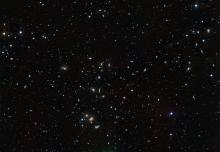Listen to today's episode of StarDate on the web the same day it airs in high-quality streaming audio without any extra ads or announcements. Choose a $8 one-month pass, or listen every day for a year for just $30.
You are here
Zeta Herculis
Most stars are born in bunches — great swarms that form from the collapse of a single cloud of gas and dust. The stars tend to stick together for a while in clusters. Over time, though, the gravity of the galaxy’s other stars and gas clouds pulls most clusters apart, so the stars go their own ways.
Even then, many of the stars can share a common motion through the galaxy — they move at the same speed, and in the same direction. Such associations are known as moving groups. And the title star of one such group climbs into view in the northeast in late evening at this time of year.
Zeta Herculis is at the top right corner of the Keystone, a pattern of four stars at the center of Hercules. It’s about 35 light-years from Earth. It actually consists of two stars. One of them is bigger, brighter, and heavier than the Sun. The other is less impressive than the Sun.
Decades ago, astronomers discovered that the system shares its motion through space with several other stars, which are spread across several constellations. That suggested that the stars were born together, so they were called the Zeta Herculis Moving Group.
Over the years, though, observations have been unable to confirm whether the stars are all the same age. So the stars of the moving group could be related — or they could just happen to share the same motion through the galaxy.
We’ll talk about a cluster in Hercules that has stuck together tomorrow.
Script by Damond Benningfield




